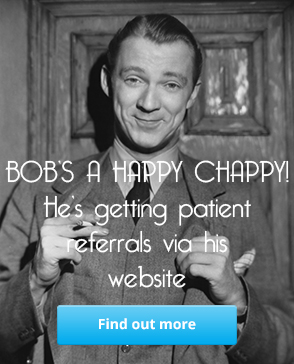Engendering Trust in Your Online Presence
-
By Geoffrey Cooling on 26th July 2015

Trust in Healthcare Relationships
Trust plays a huge part in all human relationships; it is at the core of all good relationships. When trust breaks down in a relationship, the fall out tends to be terrible, the emotions unleashed are powerful. This is as true for professional relationships as it is for personal relationships.
Trust is an important part of any relationship; in a professional relationship it is imperative. In business model terms there are recognized ways to drive trust, I would like to look at them again, and why they are so important. I would also like to outline how we use this understanding in our design and activities for our clients.
Assurance
Assurance plays a large part in the RATER model, a business model that I have used in the past many times. The RATER Model was created by professors Valarie Zeithaml,A. Parasuraman, and Leonard Berry, and published in their 1990 book, “Delivering Quality Service.” The book is an excellent read for anybody who wants to get and keep customers. It will help any healthcare business who to position their Practice for Patient Retention.
The model highlights five areas that customers/Patients generally consider to be important when they use a service. These are as a follows:
Reliability – your ability to provide the service you have promised consistently, accurately, and on time.
Assurance – the knowledge, skills, and credibility of staff; and their ability to use this expertise to inspire trust and confidence.
Tangibles – the physical evidence of the service you provide. This could be offices, equipment, employees, and the communication and marketing materials that you use including any online channels.
Empathy – the relationship between employees and customers.
Responsiveness – your ability to provide a quick, high quality service to your customers.
Assurance in the Healthcare Model
When somebody is reliant on the guidance or input of another in any situation, trust is at the core of the interaction. Trust is at the core of the relationship in healthcare in particular. I read an excellent article by Brian Taylor in relation to trust in the relationship between healthcare provider and Patient.
He said that at the very core of trust resides something called the principal-agent dilemma. To paraphrase, the principal-agent dilemma occurs when one party, the authority, in a professional relationship has more knowledge than the other.
He went on to say,
“In an audiology practice, asymmetrical information exists between the patient (principal), who often wonders whether the audiologist (agent) is recommending expensive treatment of their handicapping condition because it is truly necessary for the patient, or because the recommendation is likely to generate income for the audiologist.”
As he said, the principal-agent dilemma is associated with many professions, including dentistry, law and medicine. Prospects in each field have preconceived expectations about the quality of care or service they may receive. These expectations have been shaped through cultural norms, exposure to advertising, direct experiences and word-of-mouth. Trust is what keeps good professional relationships moving.
Trust is what makes a prospect Patient approach you for treatment at the beginning. Trust is what makes someone keep on with a course of treatment even after they have decided they don’t like it. As Brian has said, the engenderment, maintenance and promotion of that trust is your responsibility as a professional. The question is, what do they trust you to do? Again Brian states that
“The central feature of trust is the patient’s belief that the audiologist will put the patient’s interests first. When the level of trust between the patient and audiologist is high, the overall quality of care the patient receives and the success of the clinic are likely to be high. In contrast, when trust between the patient and audiologist is low, benefit, satisfaction, and even adherence to the recommendation is likely to be poor.”
That is the very core of the trust relationship between Patient & hearing healthcare professional. However, that core trust statement can be broken down into differing strands. The Patient trust is based on several implicit beliefs:
- That you and your staff are qualified to deal with their problem
- That you and your staff are technically adept with the instruments you use
- That you and your staff in fact care for them
- That you and your staff understand their individual needs
When any of these beliefs are disrupted, trust is destroyed. It is then that we face the very situation that Brian speaks about. As I have said earlier, a loss of trust is devastating to a relationship. It will sour a relationship badly and the person whose trust has been broken can be expected to react badly. In the case of a professional relationship, that breakdown in trust can lead to bad word of mouth, bad online reviews, and even possible lawsuits.
Engendering trust
It is obvious that we need to engender trust through our activities in order that we attract new Patients. It is obviously as important that we continually enforce that trust. So as I have said, in its most basic form assurance is trust, trust in you and your business to do as you say. In healthcare, it is trust in you to cure or treat a medical problem. It is also trust in you to undertake this in the promptest and efficacious manner. The rest of the RATER model can in fact help you understand clearly what you need to do to drive trust.
Driving That Trust
The key thing for us to understand is that perception of trust is built from different touchpoints. That perception of trust is being formed before a Patient ever engages with your business. We have made that understanding a core of what we do at Audiology Engine. The initial touchpoint with your business will often be through some marketing channel. That channel may be offline in traditional marketing or online. It may in fact be walking by your Practice. No matter which touchpoint it is, in the modern world every prospect will probably end up at your website.
The Psychology in Web Design
We have taken this understanding and woven it into our design principles. We use this understanding for everything we do, from website design, article writing and even social media posts. We understand that all of our writing and design needs to be engaging, but we also understand that it all has to drive the perception of trust and assurance.
The Mechanics
Let’s look deeper at the mechanics, the elements beyond good design that you can deploy to engender the perception of assurance. What do people want, at its core, they want to know that they are being looked after people who know what they are doing. So how can we meet that need in the design of a website.
The overall look, feel and design of a website will play a major part in driving the perception of efficacy. If the website looks professional, the perception is that you are a professional company. Beyond that, there are elements that if deployed can help to drive that feeling home.
Testimonials
Testimonials are key pieces of social proof, they drive trust in your business. Video testimonials are the most powerful hands down, but written testimonials accompanied by pictures are also strong.
Value Proposition Statements
Value proposition statements are based on what is of value to the Patient. In these statements we tend to err towards Practice history, perhaps free trials, money back offers etc. These statements are designed to meet the needs of the Patients.
Why Choose Us
We always add a section like this, it is the ultimate value proposition statement. We can display it in differing ways such as accordions which are headers that expand with text or timelines which are horizontal lines with differing icons and text. We also sometimes just use text sections with imagery. These elements are used to drive trust in efficacy and use strong calls to action that matter to Patients.
About Us
The about us page is used to drive efficacy, empathy and trust. We do so by detailing qualifications and personal beliefs. We also include core beliefs, mission statements and value proposition statements. We always include bios of each staff member and the details of their qualification. You should really be doing this already and many do. This page is key to your offering and your engenderment of trust.
Association Memberships
Membership of an association representative group is a powerful statement. That group maybe a professional representative association such as BSHAA or ISHAA or it may be more a commercial organisation such as AIHHP. Consultant Approved Centre or manufacturer approved centre status is another element that we consistently use when available.
How we tend to leverage that is with a prominent splash in the footer or header perhaps with a link back to the association site or to a page on your site. We tend to move towards a page on the site, with all due respect to the associations we want to keep your prospects on your site. An element like that will give some assurance to prospective Patients.
Qualifications, Study & Training
Another element that gives assurance is qualification, the training and study undertaken to perform your function. In this case it is not a company element it is a staff element. We tend to use this as part of your about us page, why choose us elements and in some of the value proposition statements. As an aside to about us pages, your main about us page can be about the overall company, its ethos, its history etc. You can even mention branch outlets if you have any.
Sub Pages For Branches & Clinics
You need to deploy sub pages as part of your site structure for every branch. This gives you further SEO opportunities for local services. In other words, your sub pages can be titled “Our hearing services in -----------“. Fill these pages with branch details, service details and Staff bios pertaining to the branch. In this way you are consistently giving yourself an opportunity to return on local searches.
Authority
Authority drives the perception of assurance, in the online world the way to gain authority is through depth of profile and content. In fact if you are including all of your members of staff in your content marketing it will help drive assurance. It will appear that all of your members of staff are competent and committed. These are just some of the elements that we use in our website design. We do so based on the changing understanding of the psychology of prospects and how we can tap into it.
Website design for healthcare is not just about pretty pictures and search engine optimisation, it is also about prospect patient psychology optimisation. The nest time you look at one of our sites or indeed any healthcare website. Consider what you are seeing in the terms that we use.
In synopsis
In order to engender trust we need to understand what drives our prospects, we then need to design our online profile to meet that understanding. If we do that properly, we can engender trust and turn prospects into enquiries, it is the job of you, your staff and the deployment of your Practice to then turn them into Patients. That is a comprehensive undertaking and is worth a whole book.
Ref: Using trust to create advocates in a world of skeptics Brian Taylor, AuD, Director of Practice Development & Clinical Affairs, Unitron US



